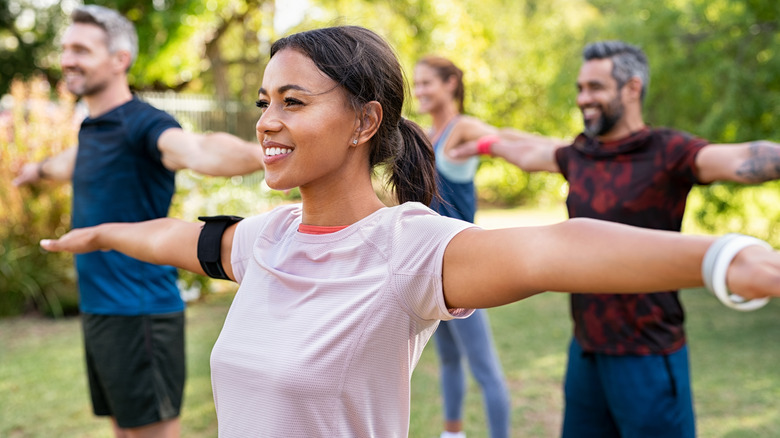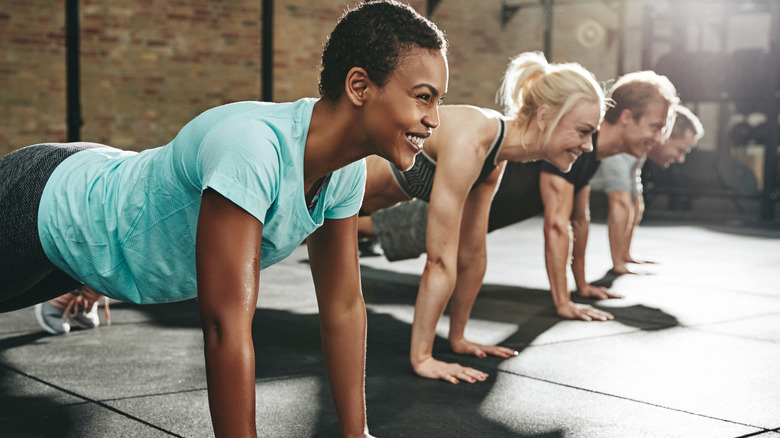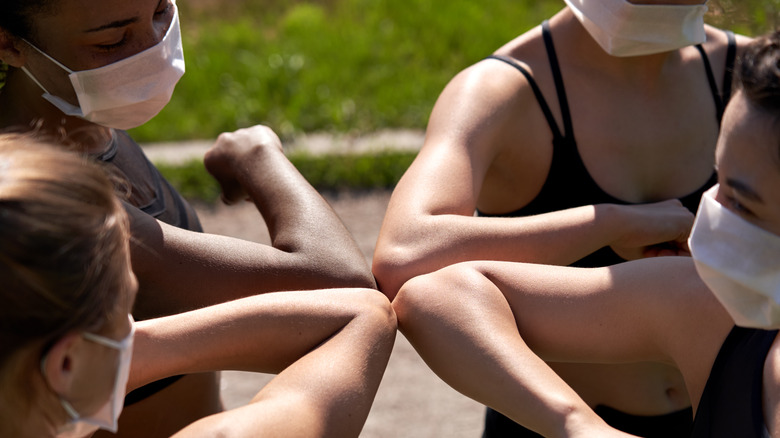The Unexpected Benefits Of Group Workouts
As the old saying goes, there's no "I" in the word team — human beings are inherently social creatures who rely on each other to accomplish their goals. In fact, social connections are so important that they are considered a basic need for humans, much like food and water (per UCLA). As discussed in a 2020 study published in Science, this need is connected to the evolution of our ancestors. The researchers found social mammals — including humans — were more likely to survive for longer when they had stronger and more supportive bonds with others of the same species.
Along with social interaction, regular exercise is an essential component of leading a longer life. Exercising is helpful for the regulation of body weight, along with the prevention of heart disease and high cholesterol, as it makes the heart stronger (per MedlinePlus). It can also lower the risk of cancer and premature death. However, 80% of Americans do not exercise as much as they should. The Cleveland Clinic recommends that adults exercise at a moderate level for at least 150 minutes each week or vigorously for 75 to 150 minutes a week. With full-time jobs and families to take care of, these recommendations might not be sustainable for many people. However, the clinic notes that any exercise is better than no exercise — being physically active whenever possible has its benefits, even if it is not as often as the guidelines propose.
Group workouts can improve your physical and mental health
One thing that can make exercising more fun is working out in groups. Group exercises come in a wide variety of options like dance classes, indoor cycling, yoga, pilates, and much more, so there's something of potential interest for everyone (per YMCA of Greater Fort Wayne).
Given that humans are wired for social connection, it may not be shocking that group workouts carry incredible benefits for our health. What may be more surprising is that exercising in a group might actually be more effective than working out alone. In a 2017 study published in The Journal of the American Osteopathic Association, medical students who regularly participated in group fitness classes reported decreased stress levels compared to medical students who exercised on their own and those who did not exercise at all.
Interestingly, other research suggests that incorporating teamwork into exercise may increase pain tolerance. A 2013 study published in the International Journal of Sport and Exercise Psychology discovered that participants who synchronized their movements while rowing together had a higher pain tolerance compared to those who rowed alone, regardless of whether they were exercising with a teammate or a stranger. In another study focused on dancing in synchrony, which was published in Evolution of Human Behavior in 2016, researchers also found this to be the case — they identified a statistically significant increase in pain tolerance among participants who synchronized their dance movements.
Group workouts can boost retention and adherence
Working out with a group can also make us more likely to want to exercise again. According to the Association for Applied Sports Psychology, at least 80% of people who start an exercise program end up withdrawing due to a lack of consistent motivation. The association recommends working out with friends to combat feeling uninspired. As it turns out, having others to help motivate us and hold us accountable may be just what we need to stick with exercise. In addition, exercising with others can also be beneficial for motivating older adults to stay physically active. A 2019 study published in the Archives of Public Health found that Norwegian participants over the age of 80 regularly attended their fitness groups and noted significant positive changes to their physical, mental and social health.
The next time you hear about a group fitness event available in your neighborhood, it could be worth checking out. Both your physical and mental health might benefit, and you could make some new friends in the process.



